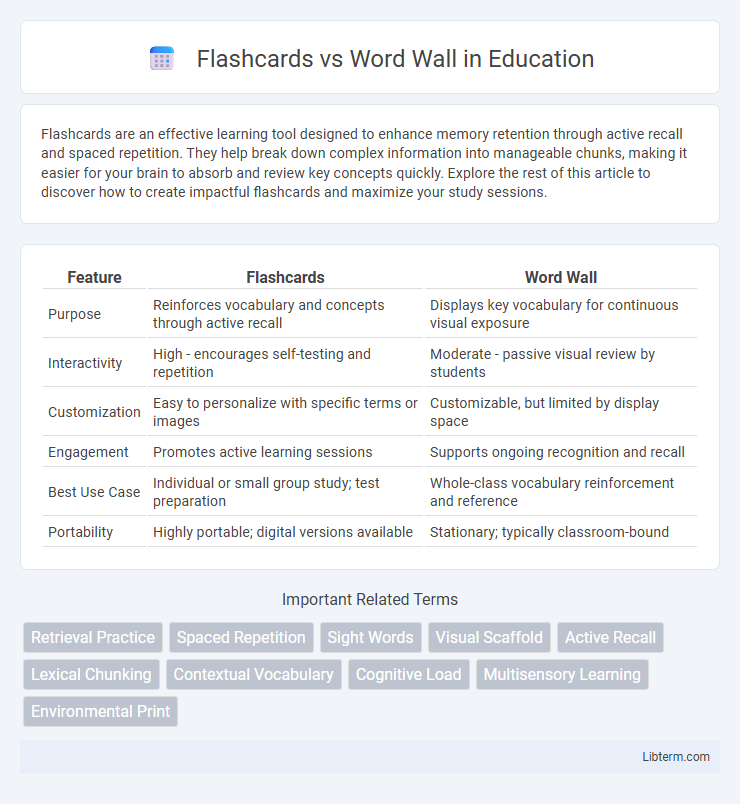Flashcards are an effective learning tool designed to enhance memory retention through active recall and spaced repetition. They help break down complex information into manageable chunks, making it easier for your brain to absorb and review key concepts quickly. Explore the rest of this article to discover how to create impactful flashcards and maximize your study sessions.
Table of Comparison
| Feature | Flashcards | Word Wall |
|---|---|---|
| Purpose | Reinforces vocabulary and concepts through active recall | Displays key vocabulary for continuous visual exposure |
| Interactivity | High - encourages self-testing and repetition | Moderate - passive visual review by students |
| Customization | Easy to personalize with specific terms or images | Customizable, but limited by display space |
| Engagement | Promotes active learning sessions | Supports ongoing recognition and recall |
| Best Use Case | Individual or small group study; test preparation | Whole-class vocabulary reinforcement and reference |
| Portability | Highly portable; digital versions available | Stationary; typically classroom-bound |
Introduction to Flashcards and Word Walls
Flashcards and word walls are effective tools for vocabulary acquisition and language learning. Flashcards enable focused, repetitive practice by presenting a term on one side and its definition or image on the other, promoting active recall and memory retention. Word walls create a visual display of key vocabulary in the classroom, enhancing recognition and contextual understanding through constant exposure and interaction.
Key Features of Flashcards
Flashcards are portable, interactive learning tools designed for repetitive memorization and active recall, enhancing retention through front-and-back cards that present questions and answers. They support spaced repetition algorithms and personalized study sessions, allowing learners to focus on challenging content and track progress efficiently. Flashcards adapt to various subjects and learning styles, making them ideal for vocabulary acquisition, factual information review, and language practice.
Key Features of Word Walls
Word Walls serve as a dynamic visual tool that organizes vocabulary words by categories, enhancing word recognition and retention through constant exposure. Each word is displayed prominently on the wall, often accompanied by images or definitions to support comprehension and contextual learning. The interactive nature of Word Walls makes them effective for group engagement and ongoing review, reinforcing language acquisition in classrooms.
Cognitive Benefits of Flashcards
Flashcards enhance cognitive benefits by promoting active recall and reinforcing long-term memory retention through spaced repetition. They engage multiple brain regions involved in visual and verbal learning, improving information processing speed and accuracy. Compared to word walls, flashcards offer personalized, self-paced learning that adapts to individual knowledge gaps, boosting deeper understanding and critical thinking skills.
Cognitive Benefits of Word Walls
Word walls enhance cognitive development by providing constant visual reinforcement of vocabulary, which strengthens word recognition and retention through spatial memory. This dynamic tool supports language acquisition by encouraging active engagement and repeated exposure, fostering connections between word meanings and phonetic patterns. Word walls also promote metacognitive skills, allowing learners to self-monitor progress and apply contextual understanding efficiently during reading and writing tasks.
Classroom Applications: Flashcards vs Word Walls
Flashcards offer targeted reinforcement for individual vocabulary words, enabling students to practice recall and pronunciation through repetitive review, which is especially effective for language acquisition and test preparation. Word walls provide a dynamic, visual classroom display of vocabulary organized by themes or word families, promoting spontaneous reference and interactive learning that supports reading fluency and vocabulary retention. Both tools enhance classroom engagement but serve distinct roles: flashcards focus on focused memorization, while word walls foster contextual understanding and continuous exposure.
Suitability for Different Learning Styles
Flashcards cater effectively to visual and kinesthetic learners by enabling active recall and repetitive practice through tactile engagement. Word walls suit auditory and social learners as they encourage group interaction and verbal reinforcement in a classroom setting. Combining both strategies adapts to diverse learning preferences, enhancing memory retention and language acquisition.
Engagement and Motivation Factors
Flashcards promote active recall and self-testing, which enhances engagement by encouraging repeated practice and instant feedback. Word Walls create a dynamic, visual learning environment that fosters motivation through social interaction and easy reference during lessons. Both tools leverage different cognitive strategies to boost learner participation and sustain interest in vocabulary acquisition.
Practical Tips for Educators
Flashcards enhance vocabulary retention through repetitive, focused practice, making them ideal for individualized learning and quick assessments. Word walls provide a dynamic, visual reference that supports collective language development and encourages spontaneous use of key terms during classroom discussions. Educators benefit from combining both strategies by using flashcards for targeted drills and word walls to reinforce contextual understanding and promote ongoing language engagement.
Conclusion: Choosing the Right Tool
Flashcards excel in individualized vocabulary reinforcement and self-paced learning, making them ideal for personal study sessions and targeted language acquisition. Word Walls, however, enhance collective engagement and contextual understanding within classroom settings, fostering collaborative language development and visual memory retention. Selecting the right tool depends on learning objectives, environment, and whether personalized repetition or group interaction drives more effective vocabulary mastery.
Flashcards Infographic

 libterm.com
libterm.com